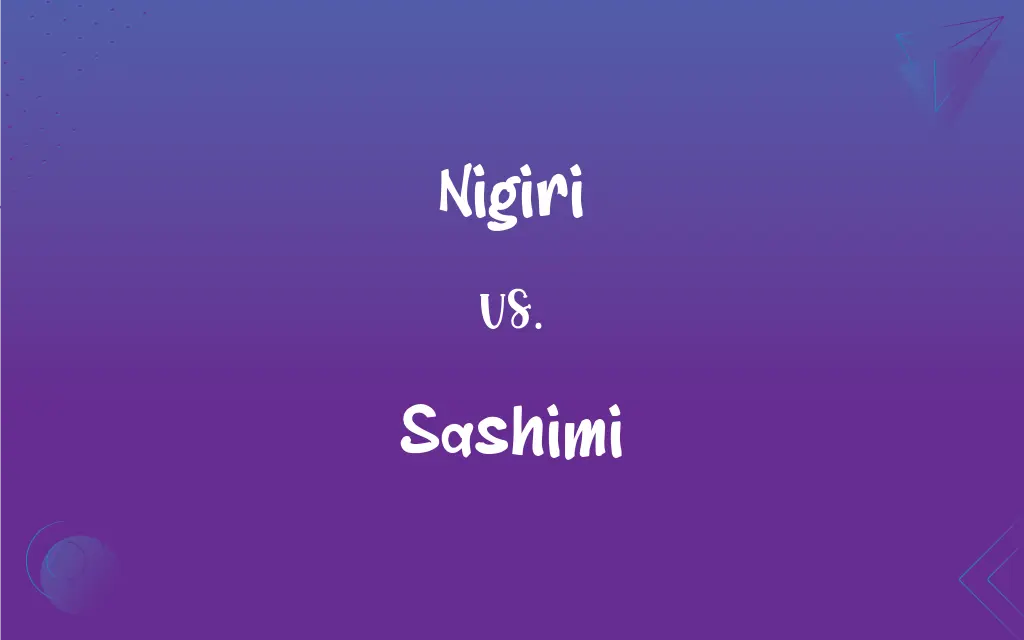Nigiri vs. Sashimi: What's the Difference?
Edited by Aimie Carlson || By Harlon Moss || Updated on October 13, 2023
Nigiri is sushi rice topped with a slice of fish. Sashimi refers to thin slices of raw fish, served without rice.

Key Differences
Nigiri and sashimi both prominently feature raw fish, yet they are presented and consumed in distinctly different ways. Nigiri is characterized by a mound of vinegared sushi rice adorned typically with a slice of raw fish. Sashimi, conversely, is focused solely on the fish, presented as thinly sliced pieces served without rice. Both exhibit the Japanese culinary artistry in utilizing fresh ingredients and showcasing subtle flavors, but through divergent methods.
In the creation of nigiri, the rice plays a crucial role, as it is often slightly warm and vinegared, providing a delicate balance to the cool, fresh fish atop it. In contrast, sashimi places the spotlight on the fish, as it is presented alone and is often enjoyed with a minimal of accompaniments, such as soy sauce and wasabi. Nigiri embraces a harmonic blend of textures and temperatures between the rice and fish, whereas sashimi allows the purity of the fish’s flavor to stand alone.
The consumption of nigiri often involves a dash of wasabi between the fish and the rice, with diners guided to dip the fish side into soy sauce. For sashimi, wasabi is commonly mixed into the soy sauce, creating a dipping mixture for the slices of fish. Even in these subtle nuances of consumption, nigiri and sashimi highlight different aspects of the culinary experience, with nigiri focusing on a melding of flavors and sashimi emphasizing the pristine quality of the fish.
When appreciating nigiri, one is experiencing the union of the slight sweetness and texture of the rice with the fresh, often delicate flavor of the fish. Sashimi, however, invites one to revel in the unadulterated flavor and texture of high-quality fish or other seafood. Both nigiri and sashimi offer a journey through the finesse of Japanese cuisine, yet they take distinctly different paths through flavor and presentation to achieve this.
In essence, nigiri and sashimi, while both being staples in Japanese cuisine, offer different experiences, flavors, and textures to the palate. Nigiri brings together carefully seasoned rice and fish, offering a balanced and layered flavor profile. Sashimi, with its elegant simplicity, provides a clean, straightforward showcase of the fish’s quality and flavor, presenting a pure and undistracted tasting experience.
ADVERTISEMENT
Comparison Chart
Definition
Sushi rice topped with a slice of fish.
Thin slices of raw fish, served without rice.
Etymology
From Japanese “nigiru” – to grasp or press.
From Japanese “sashi” (pierced) + “mi” (body).
Syllable Count
3 syllables.
3 syllables.
Use in a Sentence
"She ordered a plate of salmon nigiri."
"He prefers sashimi over other sushi types."
Key Ingredient
Vinegared rice.
Raw fish.
ADVERTISEMENT
Nigiri and Sashimi Definitions
Nigiri
Nigiri involves hand-pressed sushi rice crowned with various toppings.
At the sushi bar, the chef skillfully prepared the nigiri with fresh tuna.
Sashimi
Sashimi is thinly sliced raw fish traditionally served without rice.
The chef sliced the freshest tuna for our sashimi.
Nigiri
Nigiri is enjoyed with a light dab of soy sauce on the fish, not the rice.
Nigiri can be enhanced by dipping it lightly into a flavorful soy sauce.
Sashimi
Sashimi is a Japanese delicacy showcasing pure, unadulterated fish flavors.
Guests admired the vibrant colors of the sashimi platter.
Nigiri
Nigiri showcases simplicity and balance between rice and fish or other toppings.
Nigiri is often celebrated for its delightful balance of textures and flavors.
Sashimi
Sashimi provides a clean tasting experience, highlighting the quality of the fish.
The sashimi melted in her mouth, a testament to its exceptional quality.
Nigiri
Nigiri may be adorned with a variety of seafood, not just fish, atop the rice.
The eel nigiri was glazed with a sweet and savory sauce, pleasing to the palate.
Sashimi
Sashimi is often served with simple accompaniments like soy sauce and wasabi.
He dipped the sashimi lightly into soy sauce before savoring it.
Nigiri
Nigiri is a type of sushi featuring a slice of fish atop vinegared rice.
Nigiri often features a small amount of wasabi between the fish and the rice.
Sashimi
Sashimi can also feature other seafood, such as octopus or scallops.
The scallop sashimi presented a delicate, sweet flavor that delighted diners.
Nigiri
A type of sushi that consists of a lump of cooked, vinegar-seasoned rice rounded and pressed by hand into a loaflike shape and then topped with a thin slice of usually raw seafood, sometimes seasoned with wasabi and bound together by a strip of seaweed.
Sashimi
A Japanese dish consisting of very thin bite-size slices of fresh raw fish, traditionally served with soy sauce and wasabi.
Nigiri
Regular sushi: a piece of raw fish (or other topping) on top of a small oblong brick of sticky white rice.
Sashimi
A dish consisting of thin slices or pieces of raw fish or meat.
Sashimi
Very thinly sliced raw fish
FAQs
What defines sashimi?
Sashimi refers to thin slices of raw fish or seafood served without rice, often with soy sauce and wasabi.
Is all nigiri made with raw fish?
No, nigiri can feature raw, seared, or cooked fish and other toppings like egg or vegetables.
What is nigiri?
Nigiri is a type of sushi consisting of hand-pressed vinegared rice topped with a slice of fish.
How is nigiri prepared?
Nigiri involves hand-forming a small mound of vinegared rice and topping it with a slice of fish or other ingredient.
What distinguishes nigiri rice?
Nigiri rice is seasoned with a mixture of rice vinegar, sugar, and salt and is slightly warm and sticky.
Is sashimi considered sushi?
No, while both are Japanese dishes featuring fish, sashimi does not include rice, which is a defining component of sushi.
Can I eat nigiri in one bite?
Yes, nigiri is often crafted to be enjoyed in a single bite to experience the harmonious flavors.
What is the correct way to eat sashimi?
Sashimi is typically eaten with chopsticks and can be lightly dipped in soy sauce, optionally with a bit of wasabi.
Is rice vinegar essential for nigiri rice?
Yes, seasoned rice vinegar is typically used for flavoring and binding the sushi rice in nigiri.
Is wasabi mandatory with nigiri?
Wasabi is traditional but optional, and in nigiri, a small amount might be placed between the fish and rice by the chef.
Can sashimi be made with cooked fish?
Traditionally, sashimi is raw, but some variations might include slightly seared or cured fish.
What types of fish are commonly used for nigiri?
Common nigiri fish include tuna, salmon, eel, shrimp, and yellowtail.
What fish is popular for sashimi?
Tuna, salmon, mackerel, and yellowtail are popular choices for sashimi.
How is sashimi presented?
Sashimi is usually elegantly arranged and served on a platter, often adorned with garnishes like shiso leaves or daikon radish.
How should I choose fish for sashimi?
Selecting high-quality, sashimi-grade fish, which is fresh and safe to consume raw, is vital.
Can I make nigiri at home?
Yes, with sushi rice, fresh fish, and a bit of practice, nigiri can be made at home.
Can I use any rice for nigiri?
Sushi rice, a short-grain variety that becomes sticky when cooked, is preferred for nigiri.
Should I use soy sauce with nigiri?
Yes, nigiri can be lightly dipped in soy sauce, ideally fish-side down to avoid soaking the rice.
Is sashimi a main course or appetizer?
Sashimi can be enjoyed as an appetizer or main course, depending on the portion and dining context.
Is sashimi always fish?
While commonly fish, sashimi can also feature other seafood like scallops, octopus, or shellfish.
About Author
Written by
Harlon MossHarlon is a seasoned quality moderator and accomplished content writer for Difference Wiki. An alumnus of the prestigious University of California, he earned his degree in Computer Science. Leveraging his academic background, Harlon brings a meticulous and informed perspective to his work, ensuring content accuracy and excellence.
Edited by
Aimie CarlsonAimie Carlson, holding a master's degree in English literature, is a fervent English language enthusiast. She lends her writing talents to Difference Wiki, a prominent website that specializes in comparisons, offering readers insightful analyses that both captivate and inform.






























































